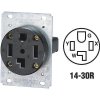I have 240V outlets in my garage - they are 4 prong 14-30R receptacles.

I have two tools which are 220V but they have this plug which I believe is a 6-20P.

There are 3 wires - green, black, and white.
How would I correctly wire a new 14-30P to that?
Do I just not wire anything to the neutral terminal in the plug?
Does it matter which terminal the white and black are connected to - i.e. white to Y, black to X, or vice versa?
I have two tools which are 220V but they have this plug which I believe is a 6-20P.
There are 3 wires - green, black, and white.
How would I correctly wire a new 14-30P to that?
Do I just not wire anything to the neutral terminal in the plug?
Does it matter which terminal the white and black are connected to - i.e. white to Y, black to X, or vice versa?







